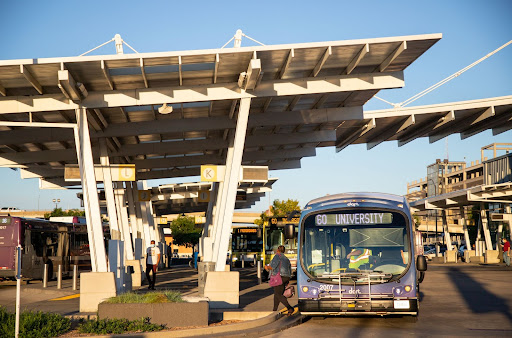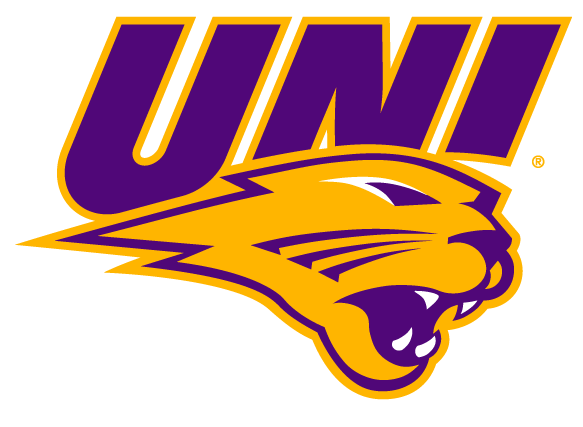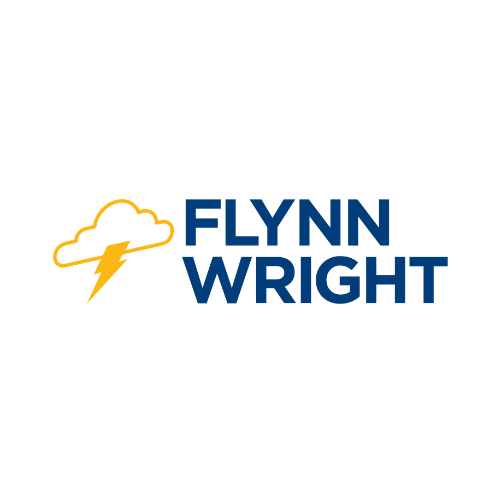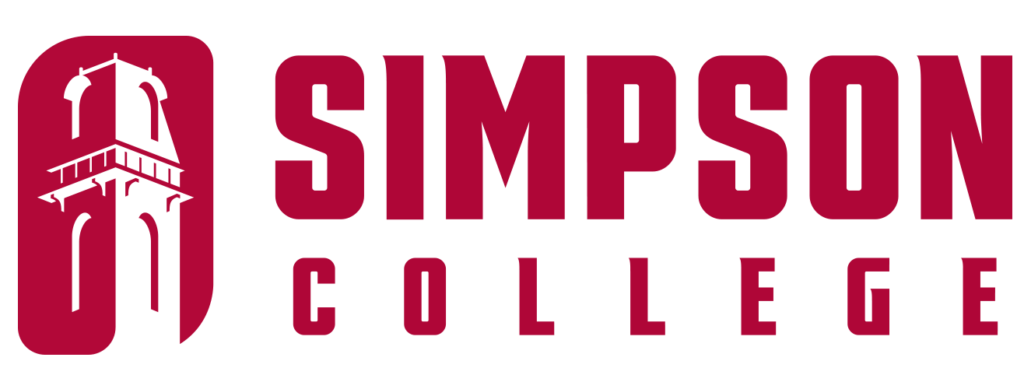DART seeking legislative action to address funding challenges

A Des Moines Area Regional Transit Authority bus is parked at DART’s Central Station in downtown Des Moines. Photo by Emily Kestel
The Des Moines Area Regional Transit Authority needs to find alternative sources for funding to reduce its reliance on property taxes and avoid a projected funding deficit of more than $4 million by fiscal year 2025, officials with the agency said.
Earlier studies, long-range plans and research by DART and the Iowa Department of Transportation showed there wasn’t adequate funding to meet Iowa’s future public transportation needs. Those included a 2017 transit funding study done by The Greater Des Moines Partnership, the DOT’s 2009 Passenger Transportation Funding Study, and the Iowa Public Transit 2050 Long Range Plan.
In recent years, officials with DART have lobbied state lawmakers to approve an alternative funding source for the transit agency. Those efforts coincided with the Legislature’s decision in 2021 to eliminate what is called the backfill or refunding local governments for cuts in commercial property taxes leaving local governments to make up the difference.
Erin Hockman, chief external affairs officer with DART, said that forced the transit agency into the decision to either increase property taxes to make up the lost revenue or seek alternative funding sources.
“So when that came about, we went back to the Legislature and said the only option we have to make up this lost revenue is increasing property taxes, given the way we’re funded today. What can we do to address our funding challenge?” she said.
DART officials worked with lawmakers, and during the 2021 session the Senate passed a bill creating a local option public transit hotel-motel tax, but the measure never gained traction in the House. After another failed attempt at the hotel-motel tax in 2022, lawmakers formed an advisory committee to study the issue of public transit funding and provide a recommendation to the Legislature by Dec. 15.
Under DART’s current funding, 62% of its revenue comes from property taxes. DART’s funding also comes from the federal government (19%), fares and contracts (12%), and state funding (4%), with the remaining 3% coming from other sources.
According to a report DART provided to committee members, its operating revenue is currently flat, resulting in increases in property taxes. One challenge is that the property tax levy for DART is capped at 95 cents per $1,000 valuation.
“As some communities start to reach that 95-cent cap, that means their levy can’t increase anymore, and the rest of the communities then have to grow even more to account for that lack of growth in those communities that have reached the cap,” Hockman said.
The city of Des Moines has already reached its cap, and made a three-year commitment to budget over that cap, but there is only one more year left on that agreement, said Elizabeth Presutti, CEO of DART, who will be leaving her position at the end of the year because her husband accepted a job with Collins Aerospace in North Carolina.
“They’re willing to do that, but not in perpetuity,” she said. “So that’s where the rubber hits the road at the Legislature on this.”
If an alternative funding source is not found, Presutti said it’s possible the DART commission can take measures to stave off the funding gap until 2025.
“We’re trying to stretch some of our CARES Act and COVID dollars as much as we can, so we’re feeling confident we’ll probably be able to stretch it to FY 25 to cover any caps, but that is probably the longest we’ll be able to go,” Presutti said.
If an alternative funding source is not approved by lawmakers in time to avoid that, cuts would have to be found, she said. That could include a reduction in hours when routes run, the possible elimination of routes and a reduction in hours at the customer service center.
Hockman said there are “a lot of ways [reductions] could be approached.”
“As we worked through our five-year financial plan and as we’re continuing to work with the Legislature, the commission has asked us to start to look at what are some of those different approaches so that we can be prepared to start having those conversations if we’re not successful during this upcoming session,” she said.
The advisory committee
The committee is made up of both voting and nonvoting members, with Kraig Paulsen, director of the Iowa Department of Management and the Iowa Department of Revenue, and Scott Marler, director of the Iowa Department of Transportation, serving as co-chairs. Other members include elected officials from member communities. Nonvoting members include four state legislators, two from each chamber representing both Democrats and Republicans.
As part of the committee’s review, 13 other public transit agencies were evaluated to determine their funding sources. Those communities were Omaha, Kansas City, Mo., Akron, Ohio, Columbus, Ohio, Dayton, Ohio, Grand Rapids, Mich., Tulsa, Okla., Little Rock, Ark., Oklahoma City, Spokane, Wash., Corpus Christi, Texas, Indianapolis and Madison, Wis.
What the evaluation found was that there was a mix of funding sources used by those cities, with nine using sales taxes. Three used primarily property taxes to fund their transit systems, with one, Indianapolis, using a combination of income and property tax.
“Most transit systems of our size aren’t funded through property taxes, so as we look at other systems and their funding, it is consistent with our desire to reduce our reliance on property taxes to try to diversify with other sources of revenue,” Hockman said.
DART’s operating budget for the current fiscal year is $40.4 million, about $25 million of which comes from property taxes. The amount DART will need to collect from property taxes is projected to increase to $31.2 million in FY 25.
Hockman said there are few revenue sources that are “politically palatable” that could reduce property taxes. One is the hotel-motel tax. Another is sales tax.
A 5% hotel-motel tax would generate $17.5 million, reducing the amount needed through property taxes to $13.7 million, Hockman said.
A one-eighth of a penny sales tax would generate $15.9 million, which would reduce the amount needed in property taxes to about $15 million, she said.
A sales tax would also benefit all transit systems statewide, which Hockman said she believed is “definitely a factor that will be considered.”
Stuart Anderson, director of the Transportation Development Division at the Iowa DOT, said that during its meetings, the committee sought more information about the hotel-motel tax and sales tax options. But he said there are other options that could be considered, and no specific recommendation was expected to be made when the committee’s report is presented to the Legislature on Dec. 15.
“I think the conclusion of the committee was that there isn’t a clear-cut, ideal answer to what the alternative funding mechanism that best fits DART would be,” Anderson said. “There are pros and cons with every alternative funding mechanism, so they didn’t feel it was appropriate to make a specific funding recommendation. But they felt providing this report with all this information would still be a really useful tool for the Legislature when they come into session.”
Anderson oversees long-range planning and program development for all modes of transportation in Iowa. Although he does not serve on the advisory committee, he participated in the meetings and was speaking at the request of committee co-chair Marler, who was not available to be interviewed.
Johnston Mayor Paula Dierenfeld, who sat on the committee and is a member of the DART commission, said the advisory committee did not have enough time in just two meetings to analyze and formulate a specific recommendation.
“The report should position the Legislature well to take the next step and find a solution to the funding problems faced by DART and other public transit systems in the state,” she said in an email response to the Business Record.
Public transit as a workforce issue
DART is Iowa’s largest public transit agency, serving 11 cities and Polk County. Its average daily weekday ridership in 2019 was nearly 15,000, and while that fell off during the pandemic, it has rebounded to nearly 12,000 today.
According to data provided by DART, 88% of its riders have a total household income of less than $50,000 a year. Forty-two percent don’t have a working vehicle in their household, with 30% having just one vehicle. According to DART data, 46% of its riders don’t have a valid driver’s license.
According to Hockman, the No. 1 reason people ride DART is to get to and from work, a statistic supported by the United Way of Central Iowa’s Central Iowa Transportation Analysis that was done with other community partners in 2019 and 2020. That analysis showed that 64% of DART riders take the bus to and from work.
Luke Lynch, OpportUNITY director for United Way of Central Iowa, said providing access to public transportation is one of the basic needs for a thriving community, along with access to quality, affordable child care, housing, food and health care.
“Those are all areas that are taking up the majority of budgets for folks, and if we can stabilize those things and make sure those things are taken care of, then people begin to be on the road to self-sufficiency,” Lynch said. “Transportation is such a big part of it. It’s so interconnected but transportation, we see it prevalent through all areas of our conversations and our work here at United Way in Central Iowa.”
He said ensuring access to transportation is critical to developing the state’s workforce as studies show the Des Moines region will hit 1 million people by 2040.
“So that workforce is coming and we just need to be ready for it,” Lynch said. “The majority of those jobs are going to be making $75,000 and less household income, and 80% of all jobs in the region are held by commuters. So as we continue to grow, we need to be more aware of that transportation piece.”
Lynch said access to public transportation is also high on the list of companies’ criteria when looking to move to a community.
“When they’re looking at the workforce, one of those conversations is, how are we going to get here? Are we on a bus line? Do we have reliable public transit? That’s why it’s so important to have this conversation about DART.”
Hockman said the region has already experienced cases where a major employer was looking to relocate and “there was an expectation that the facility would have transit service.”
She cited DART extending a route to serve the Amazon facility in Bondurant as one example.
“Communities aren’t considered if they don’t have not just good transit service, but robust transit service,” Hockman said. “It’s one of the No. 1 things they look for. It’s not just workforce attraction but it’s also economic development and how do we get more employers to choose Central Iowa as a place to run their business.”
Dierenfeld said a significant number of DART riders are the elderly or people with a disability, and who take a bus to doctors’ appointments, the grocery store and other places. She also said with Johnston’s redevelopment of the Merle Hay corridor, maintaining a vibrant public transit service will be critical.
“With a major sports facility and golfing venue at the south end and the new Johnston Town Center at the north end, we expect the properties along the entire stretch to develop with new hotels, restaurants, breweries and retail shops,” she said. “The entire corridor will demand a workforce that can be served best by public transportation. We also expect visitors to these new entertainment and shopping destinations to utilize DART service as well.”
What’s next?
With a Dec. 15 deadline looming for the advisory committee to submit its report to the Legislature, Presutti said she is optimistic that lawmakers will take action during their 2023 session, which convenes on Jan. 9.
“We had legislation on the Senate side and it had gone all the way until the final negotiation two years ago, and we continued to make ground last year, and I think that’s telling in the fact they put together the legislative committee,” she said. “They could have just chosen not to have the conversation at all. Anything we can do to continue the conversation provides a lot of optimism.”
Hockman said with the mutual goal of reducing property taxes, “there is alignment in the overall goals of what we’re trying to achieve at the local and state level. It’s really just a conversation about how do we achieve that and getting consensus on that.”
Calls and emails to lawmakers, both those serving on the committee and leaders of both chambers, seeking comment went unanswered. One lawmaker sitting on the advisory committee, Sen. Janet Peterson, D-Des Moines, referred questions to Senate Republican Majority Leader Jack Whitver.
Dierenfeld said she’s optimistic lawmakers will find a funding solution not only for DART but for all public transit systems in Iowa.
“As the demand for public transportation grows, the problems related to funding will increase,” she said. “While it won’t be easy, I’m hopeful the Legislature will take the information the advisory committee submits in its report and develops a solution that truly fixes the problem now and into the future.”
Presutti said Iowa is behind other states in how it approaches funding for public transportation.
“It’s concerning because when you think about all these peer transit systems are having these conversations in a meaningful way,” she said. “You go two hours down the road in Omaha and Council Bluffs, that is the main focus of a lot of their planning efforts. When they think about the growth of Omaha and the surrounding communities, transportation is the underlying fabric of it. They’re considering a streetcar to connect Council Bluffs and Omaha, and we can’t get past the conversation of whether we want to fund it some days. If we don’t start to have that conversation in a meaningful way, we are going to lose ground in our ability to attract workforce to the region.”











